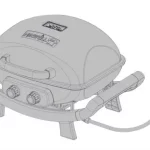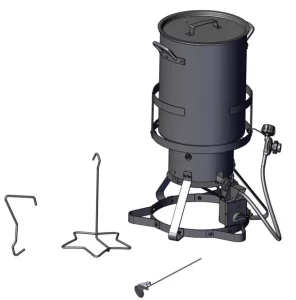

Turkey Fryer
Model: 840-0005 30
Owner’s Manual
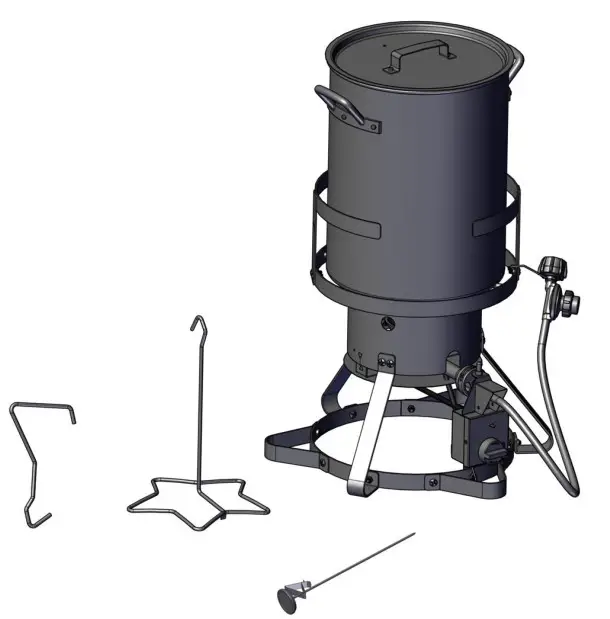
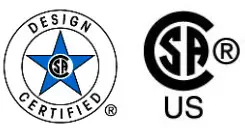
- This instruction manual contains important information necessary for the proper assembly and safe use of the appliance.
- Read and follow all warnings and instructions before assembling and using the appliance.
- Follow all warnings and instructions when using the appliance.
- Keep this manual for future reference.
Safety Instructions

If you smell gas:
- Shut off gas to the appliance.
- Extinguish any open flame.
- If odor continues, keep away from the appliance and immediately call your gas supplier or your fire department.
Failure to follow these instructions could result in fire, explosion or burn hazard, which could cause property damage, personal injury or death.

a) Do not store a spare LP-gas cylinder under or near this appliance.
b) NEVER fill the cylinder beyond 80 percent full.
c) If the information in “a” and “b” is not followed exactly, a fire or explosion causing death or serious injury may occur.
DANGER
- Never operate this appliance unattended.
- Never operate this appliance within 3.05 m / 10 ft. of any structure, combustible material or gas cylinder.
- Never operate this appliance within 7.62 m / 25 ft. of any flammable liquid.
- Heated liquids remain at scalding temperatures long after the cooking process.
Never touch the cooking appliance until liquids have cooled to 46 ºC / 115 ºF or less. - If a fire should occur, keep away from the appliance and immediately call your fire department. Do not attempt to extinguish an oil or grease fire with water.
Failure to follow these instructions could result in fire, explosion or burn hazard, which could cause property damage, personal injury, or death.
THIS GAS APPLIANCE IS DESIGNED FOR OUTDOOR USE ONLY
Please read the following instructions carefully before attempting to assemble, operate or install the product. Failure to follow these instructions may result in serious bodily injury and/or property damage. If you have questions regarding the product, please call our Customer Service Department at U.S.A:1-800-913-8999, 8 a.m. – 5 p.m., PST, Monday-Friday. Make sure you have the serial number available.
LP gas supply cylinder to be used must be constructed and marked in accordance with the specifications for LP gas cylinders of the U.S. Department of Transportation (DOT) or the National Standard of Canada, CANB339, Cylinders, Spheres and Tubes for the Transportation of Dangerous Goods.
CALIFORNIA RESIDENTS ONLY – WARNING: This product and the fuels used to operate this product (liquid propane), and the products of combustion of such fuels, can expose you to chemicals including benzene, which is known to the State of California to cause cancer and reproductive harm.
For more information go to: www.P65Warnings.ca.gov.
- The installation must conform with local codes or, in the absence of local codes, with the National Fuel Gas Codes, the National Fuel Gas Code, ANSI Z223.1/NFPA 54, Storage and Handling of Liquefied Petroleum Gases, ANSI/NFPA 58, or the Standard for Recreational Vehicles, ANSI A119.2/NFPA 1192, and the Recreational Vehicle Code, CSA Z240 RV, as applicable.
- This appliance shall not be used on or under any apartment or condominium balcony or deck.
- This appliance shall be used only outdoors, and shall not be used in a building, garage or any other enclosed area.
- This appliance is not intended to be installed in or on a boat and/or recreational vehicles.
- Keep appliance at least 10 ft (3m) from any combustible materials and wall. Keep at least 10 ft (3m) from such materials on the sides and back of the appliance, and the appliance must not be located under overhead unprotected combustible construction. Never use under balconies made of wood or ANY overhead construction.
- Keep the fuel supply hose away from any heated surfaces.
- This appliance is NOT intended for commercial use.
- The use of alcohol, prescription or non-prescription drugs might impair the consumer’s ability to properly assemble or safely operate the appliance.
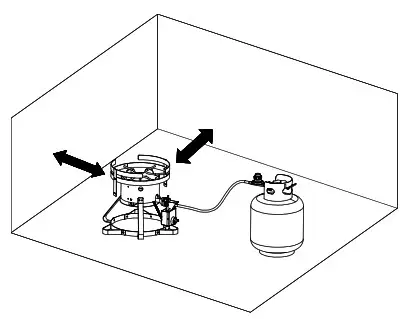
- When cooking with oil or grease, have a type BC or ABC fire extinguisher readily available. In the event of an oil or grease fire DO NOT attempt to extinguish with water. Immediately call the FIRE DEPARTMENT. A Type BC or ABC fire extinguisher may, in some circumstances contain the fire.
- In the event of rain, snow, hail, sleet or other forms of precipitation while cooking with oil or grease, cover the cooking vessel immediately and turn off the appliance burners and gas supply. DO NOT attempt to move the appliance or cooking vessel.
- When cooking, the appliance fryer/boiler MUST BE ON A LEVEL, STABLE NONCOMBUSTIBLE SURFACE in an area clear of combustible material. An asphalt surface (blacktop) is not acceptable for this purpose.
- DO NOT leave the appliance unattended. Keep children and pets away from the appliance at all times.
- Do not place an empty cooking vessel on the appliance while in operation. Use caution when placing anything in the cooking vessel while the appliance is in operation.
- Do not move the appliance when in use. Allow the cooking vessel to cool to 115 ºF (45 ºC) before moving or storing.
- For outdoor use only. If stored indoors, detach and leave cylinder outdoors.
- This appliance is not intended for and should never be used as a heater.
- When cooking with oil or grease, the thermometer provided MUST be used. Follow instructions in this manual for proper installation and use of the thermometer. If the thermometer supplied with this fryer/boiler has been lost or damaged, a replacement thermometer must be one specified by the appliance manufacturer.
- This appliance will be HOT during and after use. Use insulated oven mitts or gloves for protection from hot surfaces or splatter from cooking liquids.
- If the temperature exceeds 400 ºF (200 ºC) or if oil begins to smoke, immediately turn the burner or gas supply OFF and wait for the temperature to decrease to less than 350 ºF(175 ºC) before relighting the burner according to the manufacturer’s instructions. If there is a lid (cover), do not remove the lid.
- It is recommended that the cooking vessel not exceed 30QT & 12” diameter. A BIGGER VESSEL MAY RESULT IN TIPPING.
- Never use a cooking vessel larger than the capacity and diameter recommended by the manufacturer.
- Never overfill the cooking vessel with oil, grease or water than specified by vessel manufacturer instruction. If the vessel doesn’t indicate the maximum fill line, please refer to the following instructions for determining the maximum fill level. Determining the maximum fill level when using a vessel without a maximum line: (1) Place the food product in the basket. (2) Place the food product and holder into the empty vessel. (3) Fill the vessel with water just until the food product is completely submerged. There must be a minimum of 3 inches (8 cm) between the water level and top of the vessel. (4) Remove the food product from the vessel and either mark the water level on the side of the vessel or measure the amount of water in the vessel. (5) Remove the water and completely dry the vessel and the food product. (6) This is the amount of cooking oil the vessel is to be filled with to cook the food product.
- Introduction of water or ice from any source into the oil/grease may cause overflow and severe burns from hot oil and water splatter. When frying with oil/grease, all food products MUST be completely THAWED and towel DRIED before being immersed in the fryer.
- Avoid bumping into or impacting the appliance to prevent spillage or splashing of the hot cooking liquid.
- Never drop food or accessories into hot cooking liquid. Lower food and accessories slowly into the cooking liquid in order to prevent splashing or overflow. When removing food from the appliance care must be taken to avoid burns from hot cooking liquids.
NATURAL HAZARD • SPIDERS
FACT: Sometimes spiders and other small insects climb into the burner tube. The spiders spin webs, build nests and lay eggs. The webs or nests can be very small, but they are very strong and can block the flow of gas. Clean burner prior to use after storing or after a period of one month not being used.

The Fuel System:
Gas appliances are used safely by millions of people when following simple safety precautions.
The items in the fuel system are designed for operation with this appliance. They must not be replaced with any other brand. (See parts list for replacement items.)
GAS BURNER: The gas burner is constructed of stainless steel and should not require maintenance other than inspection for insects/nests inside the air intake slots.
LP GAS REGULATOR CAUTION:
The gas pressure regulator provided with this appliance must be used. This regulator is equipped with the required orifice and is set for the required outlet pressure for this appliance. This combination of orifice size and pressure regulation specifications provides the cooking performance intended by the appliance.
Substitution of regulators by any other device or any other manufacturer is dangerous and could result in serious injury.
PROPANE FUEL: Warning – propane is a flammable gas. Improper handling may result in an explosion and/or fire and serious accidents or injuries. Your appliance is designed to operate with propane (LP) gas only and is equipped with the proper orifice for propane gas.
Caution: Do not connect this appliance with any gas supply other than propane. Propane gas is heavier than air and settles in lower areas. Make certain adequate ventilation is available when using your appliance. The gas cylinder may be stored outside in a well-ventilated area out of the reach of children when the appliance is not in use.
The LP gas cylinder shall be used only outdoors in a well-ventilated space and not in a building, garage, or any other enclosed area. The appliance may be stored indoors if the LP gas cylinder is removed and stored outdoors. The LP gas cylinder (not included) is threaded for connection directly to the gas regulator supplied with this appliance. Care should be taken when threading the cylinder to the regulator to engage threads correctly to achieve the proper and intended connection. When disconnecting or connecting the gas cylinder, be careful that the regulator does not strike the appliance, the ground, or any other surfaces. Replace the protective cap over the threaded cylinder connection when removed from the appliance. If any difficulty occurs when connecting or disconnecting the cylinder to the regulator assembly, contact your local gas supplier for assistance.
When reconnecting the LP gas cylinder to the regulator, be sure to hand-tighten until snug. This connection should be inspected for damage and leak-tested after each reconnection.
To-Do a Leak Test, make a soap solution of one part liquid detergent and one part water. You will need a spray bottle, brush, or rag to apply the solution to the fitting. Bubbles indicate leaks.
Check all gas supply fittings for leaks before each use. Do not use the appliance until all connections have been checked and do not leak.
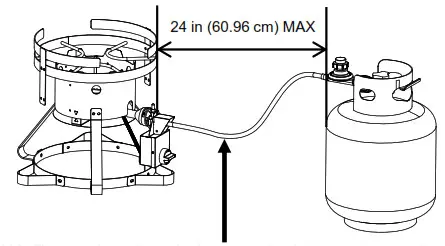
WARNING: The gas hose is a tripping hazard, which can tip over the appliance and propane tank, causing serious personal injuries or property damage.
Tools Needed
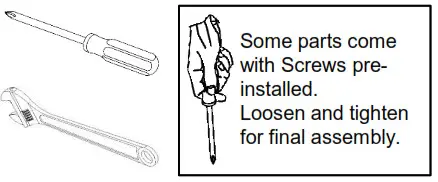
Hardware package list
| Truss Head Screw 1/4-20 x 1/2” |
Hex Nut 1/4-20 |
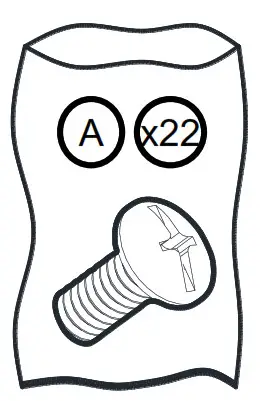 |
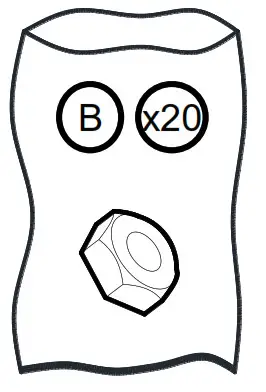 |
Package Parts List
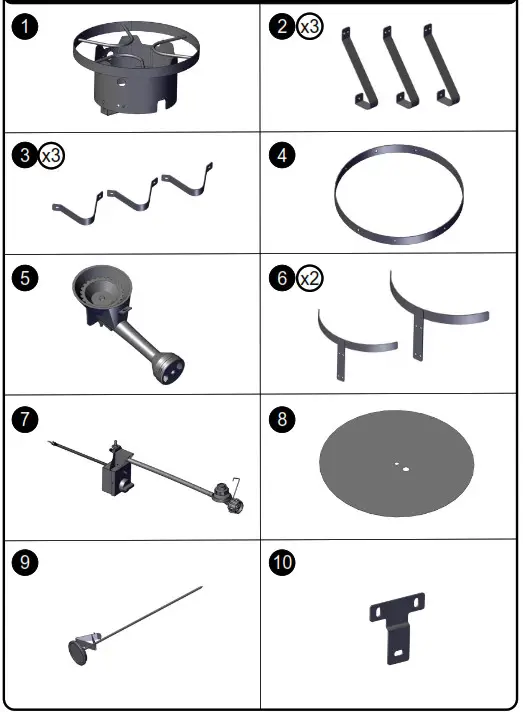
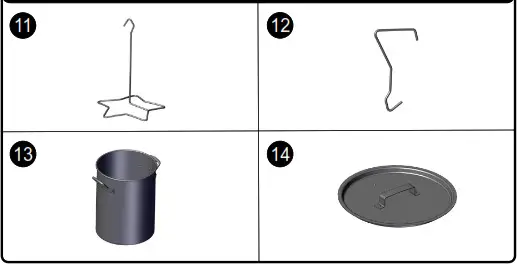
Assembly Steps
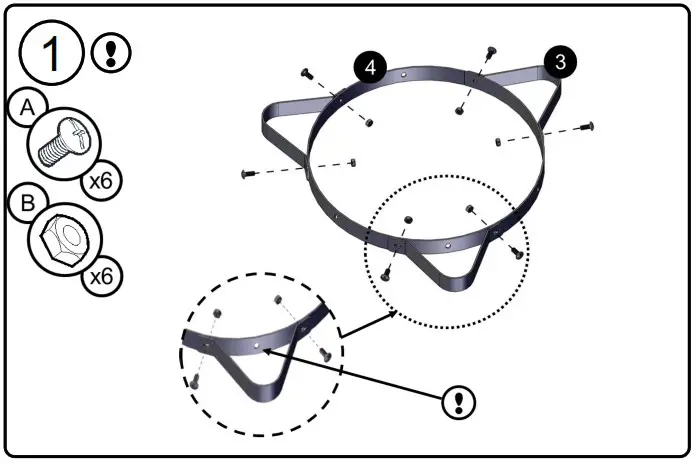
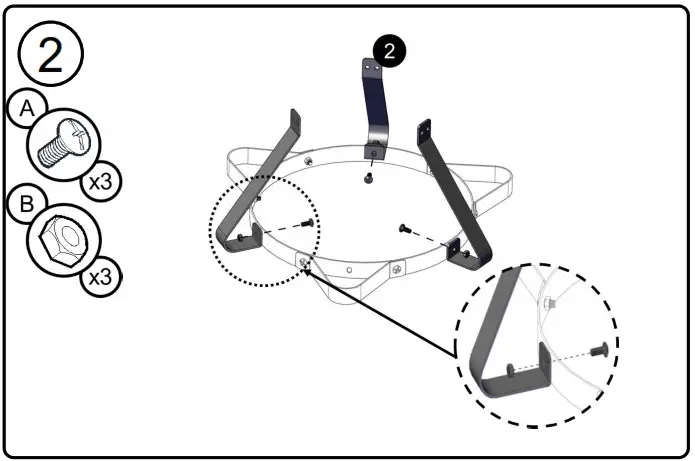
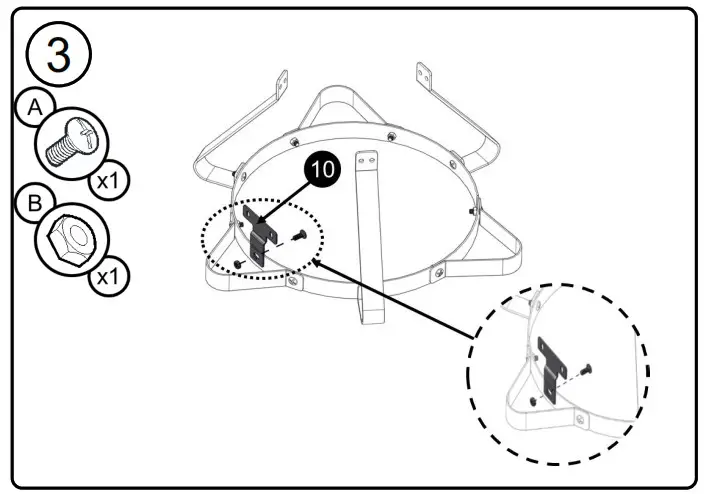
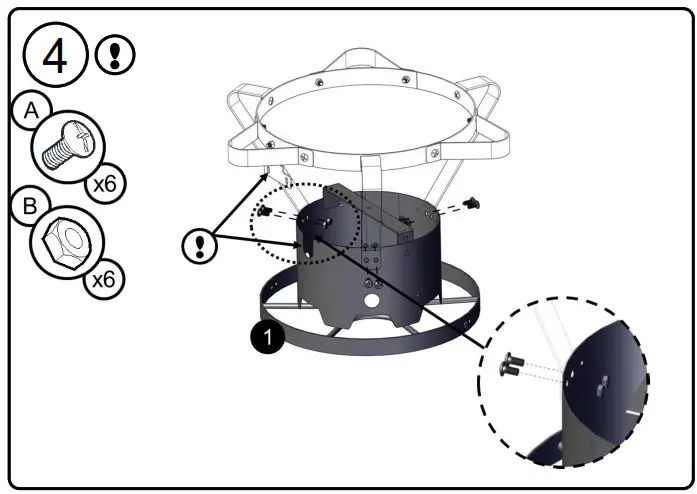
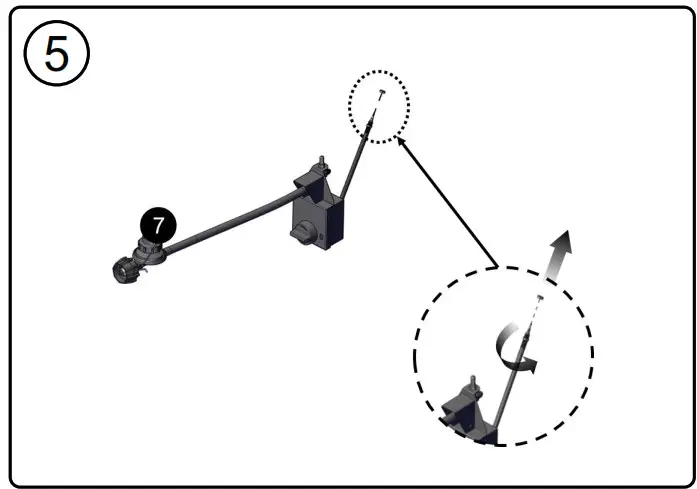
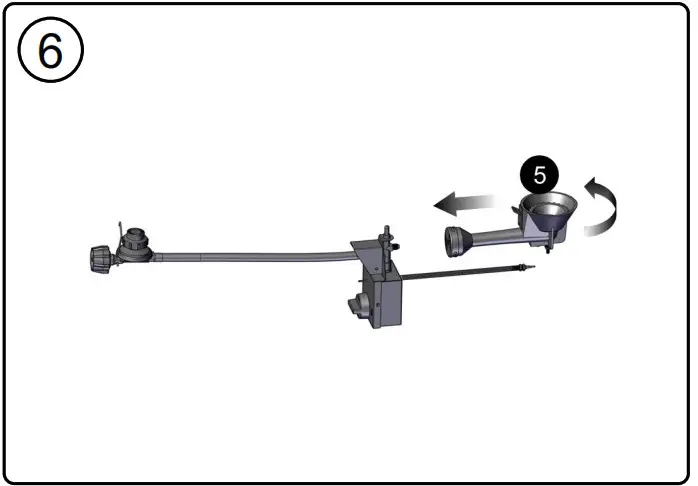
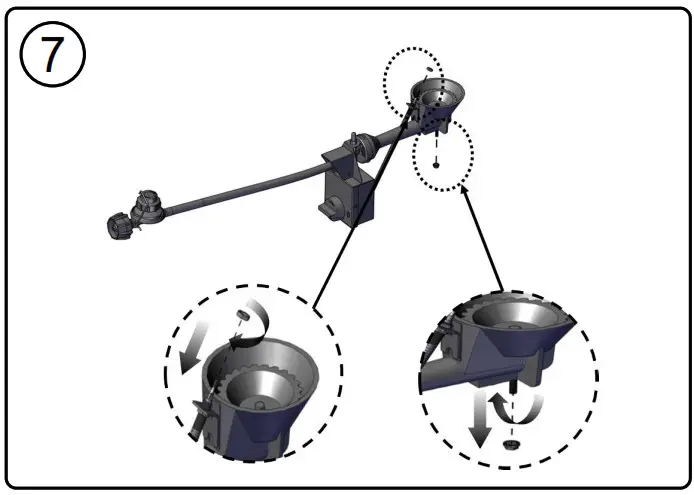
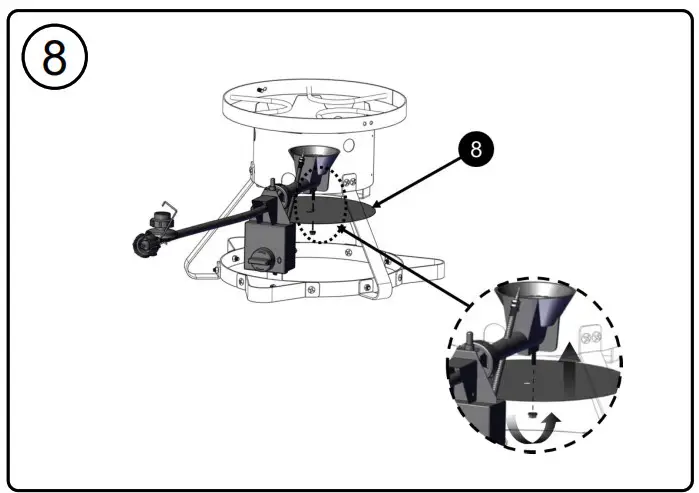


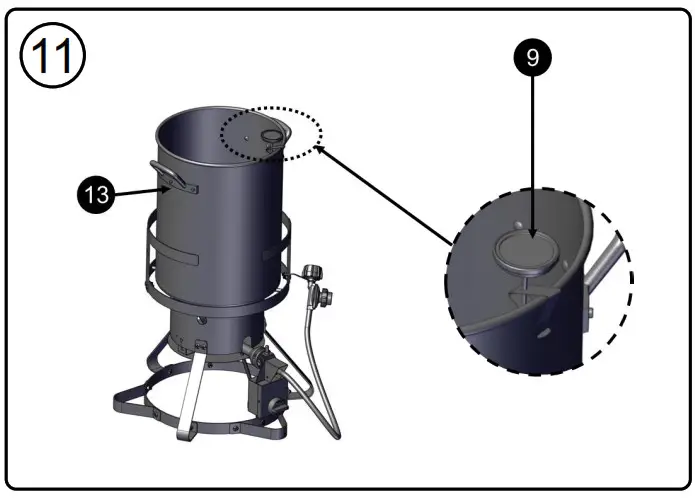
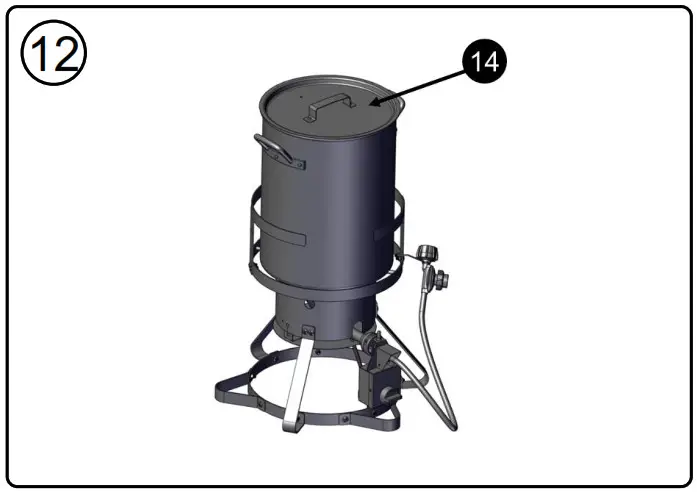
Operating instructions
GAS HOOK-UP
Only the pressure regulator and hose assembly supplied with the appliance should be used. Any replacement pressure regulator and hose assembly must be specified by the appliance manufacturer. This grill is configured for liquid propane. Do not use a natural gas supply.
Total gas consumption (per hour): 38,000 BTU
The installation of this appliance must conform with local codes or, in the absence of local codes, with either the National Fuel Gas Code, ANSI Z223.1/NFPA 54, National Gas Propane Installation Code, CSA B149.1, or Propane Storage and Handling Code.
LIQUID PROPANE CYLINDER REQUIREMENTS
The LP tank used with your appliance must meet the following requirements:
- Purchase LP tanks only with these required measurements: 12”(30.5cm)(diameter) x 18”(45.7cm)(tall) with 20lb. (9kg) capacity maximum.
- The LP-gas supply cylinder to be used must be constructed and marked in accordance with the specifications for LP-gas cylinders of the US Department of Transportation (DOT) or the National Standard of Canada, CAN/CSA-B339, Cylinders, Spheres and Tubes for the Transportation of Dangerous Goods.
CAUTION: Use cylinders that are marked “Propane Fuel” only.
LP TANK VALVE REQUIREMENTS
LP tank valve must have:
- Type 1 outlet compatible with regulator or appliance.
- Safety relief valve.
- UL listed Overfill Protection Device (OPD). This OPD safety feature is identified by a unique triangular handwheel. Use only tanks equipped with this type of valve.
- LP tank must be arranged for vapor withdrawal and include a collar to protect LP tank valve.
CONNECTING THE LIQUID PROPANE CYLINDER
To connect the liquid propane gas supply cylinder:
The cylinder valve should be in the “OFF” position. If not, turn the valve clockwise until it stops.
Make sure the cylinder valve has the proper type-1 external male thread connections per ANSI Z21.81.
Make sure the burner valves are in the “OFF” position.
Inspect the valve connections, port and regulator assembly. Remove debris and inspect the hose for damage.
When connecting the regulator assembly to the valve, use your hand to tighten the nut clockwise until it stops. Use of a wrench could damage the quick-coupling nut and result in a hazardous situation
Open the cylinder valve fully by turning the valve counterclockwise.
Before lighting the grill, use a soap and water solution to check all the connections for leaks.
If a leak is found, turn the cylinder valve “OFF” and do not use the grill until a local liquid propane dealer can make repairs.

DISCONNECTING THE LIQUID PROPANE CYLINDER
- Turn the control knob of the regulator to the OFF position.
- Turn LP tank OFF by turning hand wheel clockwise to a full stop.
- Turn the coupling nut counterclockwise to loosen the connector. Loose by hand only – do not use tools.
- When disconnected, the regulator should be hung on the hook attached to the appliance.
LEAK TESTING
GENERAL
Although gas connections on the appliance are leak-tested prior to shipment, a complete leak test must be performed at the installation site. Before each use, check all gas connections for leaks using the procedures listed below.
If the smell of gas is detected at any time, you should immediately check the entire system for leaks.
BEFORE TESTING
Make sure all packing materials have been removed from the grill, including any burner tie-down straps.
WARNING
Check all gas supply fittings for leaks before each use. Do not use the appliance until all connections have been checked and do not leak. Do not smoke while leak-testing. Never leak-test with an open flame.
Make a solution of one part liquid detergent and one part water. You will need a spray bottle, brush, or rag to apply the solution to the fittings. For the initial leak test, make sure the liquid propane cylinder is full.
TO TEST
- Turn the burner valve off.
- Apply the soap solution to all gas fittings. Soap bubbles will appear where a leak is present.
- If a leak is present, immediately turn the gas supply “OFF” and tighten leaky fittings.
- Turn the gas back “ON” and recheck.
- Should the gas continue to leak from any of the fittings, turn the gas supply “OFF” and contact our Customer Service Department at U.S.A:1-800-913-8999, 8 a.m. – 5 p.m., PST, Monday-Friday.
- If there is evidence of excessive abrasion or wear, it must be replaced prior to the outdoor cooking gas appliance being put into operation.
- Only those parts recommended by the manufacturer should be used on the grill. Substitutions will void the warranty.

Do not store appliances indoors unless the cylinder is disconnected. Do not store cylinders in a building, garage, or any other enclosed area, and keep out of reach of children at all times.
HOSE ASSEMBLY AND REGULATOR CHECK
Cleaning and inspection of the pressure regulator and hose assembly prior to use. If there is evidence of abrasion, wear, cuts or leaks, the hose assembly must be replaced prior to the appliance being put into operation. The replacement hose assembly shall be specified by the manufacturer.
USING YOUR THEROMOETER
The thermometer must be checked before each use. To do this, insert the thermometer into a pot of boiling water and ensure that it registers approximately 212 ± 20 ºF (100 ± 10 ºC). If it does not function properly, obtain a replacement thermometer specified by the manufacturer before using the appliance.
The thermometer should be positioned so that at least 2.75” of the thermometer tip is always submerged in oil; repositioning as needed during use. The thermometer must be used until the burner is turned off.
LIGHTING THE APPLIANCE
- Read instructions before lighting.
- Turn the regulator control valve to the OFF position.
- Turn the timer knob clockwise as far as it will go.
- Slowly open the cylinder valve.
- Have a standard match, fireplace match or long-nosed propane lighter lit and place it over the burner.
- Press and hold the safety valve button while slowly opening the regulator control valve, keeping face and body away from the top of the cooker stand.
- After the burner is lit, continue to hold down the safety valve for 10-15 seconds. If the safety valve is not held down for 10-15 seconds, the flame will not stay lit.
- If ignition does not occur in 5 seconds, turn the burner control(s) off, wait 5 minutes, and repeat the lighting procedure.
- If the appliance fails to ignite after the second attempt, see the troubleshooting section of the manual and/or call our Customer Service Department at U.S.A: 1-800-913-8999.
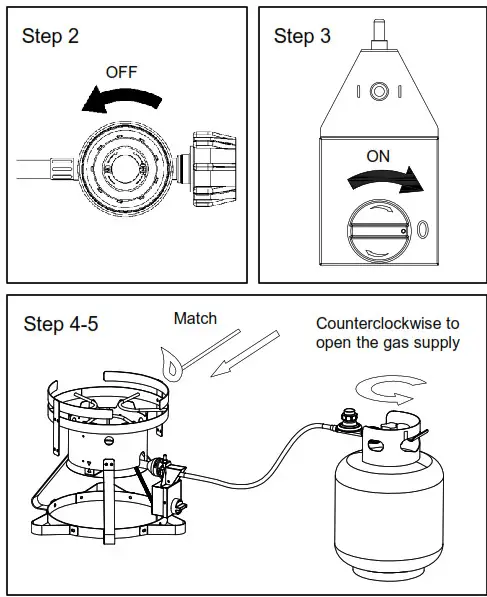
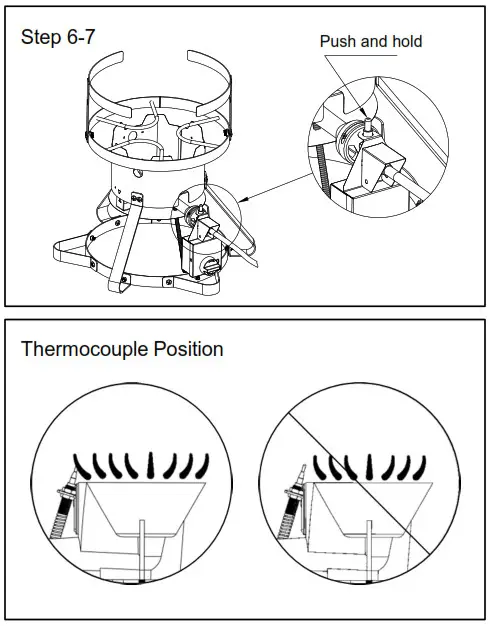
NOTE: The timer cycle is set at about 15 minutes. If the timer is not reset before the 15 minutes are up, the burner will shut off automatically. If this happens, just re-light according to the instructions above and continue to cook.
THERMOCOUPLE POSITION
If the burner will not light, check the position of the thermocouple. The nut that holds the thermocouple should be installed correctly and locked in place. The flame will not stay lit unless it has full contact with the thermocouple.
TURNING LP COOKER OFF
Turn all knobs to OFF position, turn LP tank OFF by turning hand-wheel clockwise to a full stop.
CAUTION: Never allow oil or grease to get hotter than 400 ºF or 200 ºC. If the temperature exceeds 400 ºF (200 ºC) or if oil begins to smoke, immediately turn the burner or gas supply OFF and wait for the temperature to decrease to less than 350 ºF(175 ºC) before relighting the burner according to the manufacturer’s instructions. If there is a lid (cover), do not remove the lid.
PREPARING THE TURKEY
- Thaw the turkey COMPLETELY before frying. Do not attempt to fry a frozen or partially frozen turkey. USDA recommends thawing the turkey in the refrigerator for 24 hours per 4-5 pounds.
- Remove any thermometer buttons, giblet packs, and leg holders from the turkey. Insert the star turkey lifter into the cavity of the turkey so that the legs are facing upward.
- If using a vessel without a maximum fill line, or to determine the proper amount of oil to fry your food item, follow the instructions below:
1. Place the turkey on the star lifter and lower it into the cooking vessel.
2. Fill the vessel with just enough water to cover the turkey. The water level must be at least 3 in (8 cm) below the top edge of the vessel.
3. Remove the turkey and either mark the water level on the side of the vessel or measure the amount of water. This is the amount of peanut oil to use for frying the turkey.
4. Remove the water and dry the turkey and vessel. - If using a marinade on the turkey, inject it into the thicker areas like the breasts and thighs. – Use the marinade injector as instructed on its packaging; or, in the absence of instructions, fill the injector with marinade and insert the needle into the turkey. Then, push the plunger while slowly withdrawing the needle to prevent creating large pockets of marinade.
- Pat dry the surfaces of the turkey completely to reduce oil splattering. Once dry, seasonings can be applied to the skin.
COOKING THE TURKEY
- Check the regulator hose connections and conduct a leak test prior to use.
- Make sure that there is proper clearance on all sides of the unit, that the propane tank is not too close to the appliance, and that the vessel is centered on the burner.
- Fill the cooking vessel with the amount of peanut oil determined above in the “turkey preparation” section.
– Do not place an empty cooking vessel on the appliance once the burner is lit as the cooking vessel can melt. - Attach the thermometer to the side of the cooking vessel making sure that at least 2.75” of the thermometer tip is submerged in oil.
- Light the burner as described on the previous page and heat the oil to 325 ºF (162 ºC). Never leave the fryer unattended during use.
- Once the oil reaches 325 ºF (162 ºC), the oil is at the right temperature to fry. If during the frying process the oil temperature reaches 400 ºF (204 ºC) or if the oil begins to smoke, turn the burner off immediately.
- Wearing long, insulated, flame retardant gloves, use the lift hook to slowly lower the turkey into the cooking vessel.
- Adjust the burner as necessary to maintain the oil temperature at 325 ºF (162 ºC) throughout the frying process. Do not leave the fryer unattended.
- Cook until the turkey is golden brown (approximately 3.5 minutes per pound).
- Carefully remove the turkey using the lift hook and place it on paper towels in an aluminum pan.
- Check the internal temperature of the turkey using a meat thermometer. The internal temperature should reach 180 ºF (82 ºC).
- Remove the star lifter from the turkey and allow the turkey to sit for 15 minutes before slicing so that the juices can settle back into the meat.
Care and Maintenance
There is very little care and maintenance needed. The appliance is designed and made of materials that will last many years with normal use. Following these instructions will improve the longevity of the grill and quality of cooking. To ensure safe operation of your grill, the area of cooking should always be kept free of combustible materials of any type, such as gasoline or other flammable vapors or liquids.
Outside appliance Parts – Can be cleaned easily with warm soapy water.
Burner – Extreme care should be taken when removing a burner. It must be correctly centered on the orifice before any attempt is made to relight the grill. The frequency of cleaning will depend on how often you use the grill.
Failure to properly place the burner back into position could cause a fire to occur, thereby damaging the grill and making it unsafe to operate.
Before cleaning, make sure the gas supply and regulator knob are in the “OFF” position and the burners have cooled.
To remove the main burners for cleaning:
- Remove the regulator assembly from the burner end.
- Locate the burner screw inside the firebox.
- Remove the screw and slide the burner out of the firebox.
To clean the grill burner:
- Clean the exterior of the burner with a wire brush. Use a metal scraper for stubborn stains or debris.
- Clear clogged ports with a straightened paper clip. Never use a wooden toothpick as it may break off and clog the port.
- Check and clean burners/venturi tubes for insects and insect nests. A clogged tube can lead to flashbacks.
To reinstall the main burners:
- Insert the burner into the firebox.
- Align the burner screw hole with the firebox hole, insert the screw, and tighten.
- Reinstall the regulator assembly onto the burner end.
General – This appliance, like all equipment, will look better and last longer if kept out of the weather when not in use.
Caution: Do not store propane cylinders in enclosed areas. When using a cover or moving the appliance, always wait until the appliance has cooled for at least 30 minutes.
– Do not obstruct the flow of combustion and ventilation air.
– A clogged tube can lead to a fire beneath the appliance.
This unit must be kept in an area free from combustible materials, gasoline and other flammable vapors and liquids.
Make sure all openings into the appliance body are free of blockages or debris and there are no objects or materials blocking the flow of combustion or ventilation.
Check burner air inlet openings (behind the inlet guard on the right end of the grill body) for insect nests or blockages. Make sure the slots in the burner tube are clear.
When the appliance is not in use, turn the control knob to the “OFF” position and remove the propane cylinder from the regulator. Remove the regulator from the burner.
For outdoor use only, if stored indoors, detach propane cylinder and store outdoors. Propane cylinders must be stored out of reach of children.
THIS COOKING APPLIANCE IS FOR OUTDOOR USE ONLY AND SHALL NOT BE USED IN A BUILDING, GARAGE OR ANY OTHER ENCLOSED AREA.
MOVING INSTRUCTIONS
- Caution: Never move the appliance with burner lit.
- Make sure the control knob is in the “OFF” position. Disconnect the propane cylinder from the regulator.
- Be sure the appliance has completely cooled for at least 30 minutes.

Spiders and insects can nest inside the burners of the grill and disrupt gas flow. This very dangerous condition could cause a fire behind the valve panel, thereby damaging the grill and making it unsafe for operation. Inspect the grill at least twice a year.
When to Look for Spiders
You should inspect the burners at least twice a year or immediately after any of the following conditions occur:
- Gas can be smelled in conjunction with burner flames appearing yellow.
- The grill does not reach temperature.
- The grill heats unevenly.
- The burners make popping noises.
Troubleshooting
| Problem | What To Do |
| The appliance will not light. | • Check to see if the liquid propane cylinder is empty. • Check burner ports for any blockage. Use a soft wire brush to clear plugged ports. • Check the gas orifice on the burner for an obstruction. If the orifice is blocked, clean with a needle or thin wire. NEVER USE A WOODEN TOOTHPICK. • Check to see if the thermocouple is assembled correctly. • Check that the timer’s knob is rotated to the correct position. • Make sure that you are pressing the valve switch for 10-15 seconds. |
| The burner flame is yellow or orange in conjunction with the gas odor. | • Check for spiders and insects. • Call our Customer Service Department at U.S.A:1-800-913-8999, 8 a.m. – 5 p.m., PST, Monday-Friday |
| Low heat with the control knob on the “HIGH” setting. | • Make sure the grill area is clear of dust. • Make sure the burner and orifice are clean. • Check for spiders and insects. • Is there an adequate gas supply available? • Is the grill being preheated for 15 minutes? |
If the grill is not working properly, perform each check of the following list before contacting customer service.
Exploded View
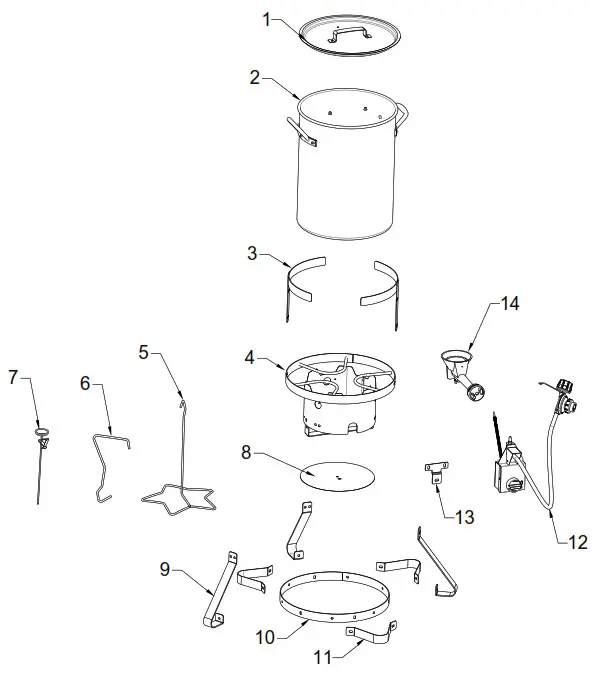
 Questions, problems, missing parts? Before returning to your retailer, call our Customer Service Department at U.S.A:1-800-913-8999, 8 a.m. – 5 p.m., PST, Monday-Friday.
Questions, problems, missing parts? Before returning to your retailer, call our Customer Service Department at U.S.A:1-800-913-8999, 8 a.m. – 5 p.m., PST, Monday-Friday.
Replacement Parts
| No. | Part (Description) | Warranty coverage | Qty |
| 1 | Pot lid assembly | 1 | 1 |
| 2 | Pot assembly | 1 | 1 |
| 3 | Pot support arms | 1 | 2 |
| 4 | Cart assembly | 1 | 1 |
| 5 | Star turkey lifter | 1 | 1 |
| 6 | Lift hook | 1 | 1 |
| 7 | 12” Deep fry thermometer | 1 | 1 |
| 8 | Bottom heat shield | 1 | 1 |
| 9 | Arc-shaped support leg | 1 | 3 |
| 10 | Bottom ring | 1 | 1 |
| 11 | V-shaped support leg | 1 | 3 |
| 12 | Regulator and safety valve assembly | 1 | 1 |
| 13 | T-shaped panel | 1 | 1 |
| 14 | Burner assembly | 1 | 1 |
Limited Warranty
Nexgrill warrants to the original consumer purchaser only that this product (Model #840-0005) shall be free from defects in workmanship and materials after correct assembly and under normal and reasonable home use for the periods indicated below beginning on the date of purchase. The manufacturer reserves the right to require photographic evidence of damage, or the return of defective parts, postage and or freight pre-paid by the consumer, for review and examination.
- MAIN BURNER: 1-year limited warranty against perforation.
- ALL OTHER PARTS: 1-Year LIMITED warranty (Includes, but is not limited to, valves, frame, housing, cart, control panel, igniter, regulator, hoses) *Does not cover chipping, scratching, cracking surface corrosion, scratches or rust.
Upon consumer supplying proof of purchase as provided herein, the Manufacturer will repair or replace the parts that are proven
defective during the applicable warranty period. Parts required to complete such repair or replacement shall be free of charge to you except for shipping costs, as long as the purchaser is within the warranty period from the original date of purchase. The original consumer-purchaser will be responsible for all shipping charges of parts replaced under the terms of this limited warranty. This limited warranty is applicable in the United States and Canada, is only available to the original owner of the product and is not transferable. The manufacturer requires reasonable proof of your date of purchase. Therefore, you should retain your sales receipt and/or invoice. If the unit was received as a gift, please ask the gift-giver to send in the receipt on your behalf, to the below address.
Defective or missing parts subject to this limited warranty will not be replaced without registration or proof of purchase. This limited warranty applies to the functionality of the product ONLY and does not cover cosmetic issues such as scratches, dents, corrosions or discoloring by heat, abrasive and chemical cleaners or any tools used in the assembly or installation of the appliance, surface rust, or the discoloration of stainless-steel surfaces. Surface rust, corrosion, or powder paint chipping on metal parts that does not affect the structural integrity of the product is not considered a defect in workmanship or material and is not covered by this warranty. This limited warranty will not reimburse you for the cost of any inconvenience, food, personal injury or property damage. If an original replacement part is not available, a comparable replacement part will be sent. You will be responsible for all shipping charges of parts replaced under the terms of this limited warranty.
ITEMS MANUFACTURER WILL NOT PAY FOR:
- Service calls to your home.
- Repairs when your product is used for other than normal, single-family household or residential use.
- Damage resulting from accident, alteration, misuse, lack of maintenance/cleaning, abuse, fire, flood, acts of God, improper
installation, and installation not in accordance with electrical or plumbing codes or use of products not approved by the manufacturer. - Any food loss due to product failures.
- Replacement parts or repair labor costs for units operated outside the United States or Canada.
- Pickup and delivery of your product.
- Postage fees or photo processing fees for photos sent in as documentation.
- Repairs to parts or systems resulting from unauthorized modifications made to the product.
- The removal and/or reinstallation of your product.
- Shipping cost, standard or expedited, for warranty/non-warranty and replacement parts.
DISCLAIMER OF IMPLIED WARRANTIES; LlMlTATlON OF REMEDIES
Repair or replacement of defective parts is your exclusive remedy under the terms of this limited warranty. The manufacturer will not be responsible for any consequential or incidental damages arising from the breach of either this limited warranty or any applicable implied warranty, or for failure or damage resulting from acts of God, improper care and maintenance, grease fire, accident, alteration, replacement of parts by anyone other than Manufacturer, misuse, transportation, commercial use, abuse, hostile environments (inclement weather, acts of nature, animal tampering), improper installation or installation not in accordance with local codes or printed manufacturer instructions.
THlS LIMITED WARRANTY IS THE SOLE EXPRESS WARRANTY GIVEN BY THE MANUFACTURER. NO PRODUCT PERFORMANCE SPECIFICATION OR DESCRIPTION WHEREVER APPEARING IS WARRANTED BY MANUFACTURER EXCEPT TO THE EXTENT SET FORTH IN THlS LIMITED WARRANTY. ANY IMPLIED WARRANTY PROTECTION ARISING UNDER THE LAWS OF ANY STATE OR PROVINCE, INCLUDING IMPLIED WARRANTY OF MERCHANTABILITY OR FITNESS FOR A PARTICULAR PURPOSE OR USE, IS HEREBY LIMITED IN DURATION TO THE DURATION OF THlS LIMITED WARRANTY.
Neither dealers nor the retail establishment selling this product has any authority to make any additional warranties or to promise
remedies in addition to or inconsistent with those stated above. The manufacturer’s maximum liability, in any event, shall not exceed the documented purchase price of the product paid by the original consumer. This warranty only applies to units purchased from an authorized retailer and or re-seller. NOTE: Some states and provinces do not allow an exclusion or limitation of incidental or consequential damages, so some of the above limitations or exclusions may not apply to you; this limited warranty gives you specific legal rights as set for herein. You may also have other rights, which vary from province to province.
If you wish to obtain performance of any obligation under this limited warranty, you should write to:
Nexgrill Customer Relations
14050 Laurelwood Place,
Chino, CA 91710
All consumer returns, parts orders, general questions, and troubleshooting assistance can be acquired by calling our Customer
Service Department at U.S.A:1-800-913-8999, 8 a.m. – 5 p.m., PST, Monday-Friday.

© 2020 NEXGRILL INDUSTRIES, INC.
CHINO, CA. 91710
WWW.NEXGRILL.COM
1-800-913-8999
